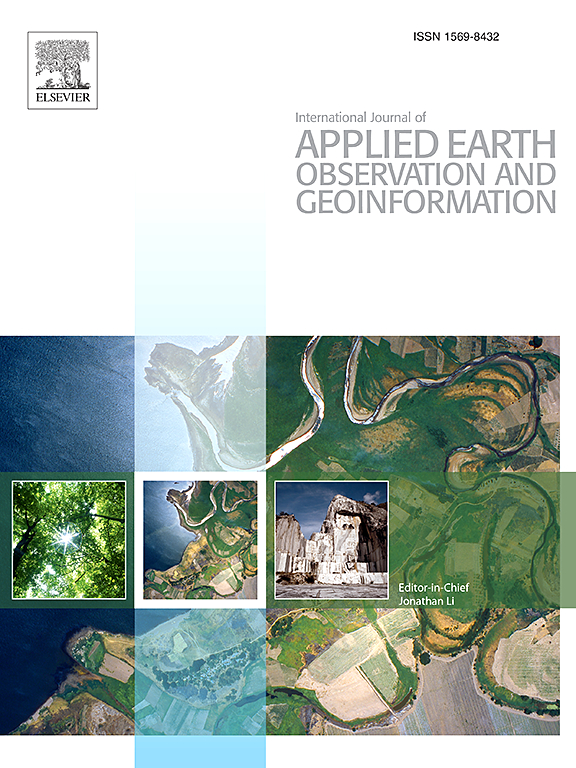Estimating two-decadal variations of global oceanic particulate organic carbon using satellite observations and machine learning approaches
IF 7.6
Q1 REMOTE SENSING
International journal of applied earth observation and geoinformation : ITC journal
Pub Date : 2025-02-21
DOI:10.1016/j.jag.2025.104438
引用次数: 0
Abstract
Particulate organic carbon (POC) is fundamental to the marine carbon cycle, yet accurately estimating its concentration from satellite data remains challenging. In this study, we developed a novel machine learning framework that incorporates multiple data streams, covering apparent and inherent optical properties, biological indicators, and environmental variables, to improve global POC retrieval. Our model achieved high accuracy, with a Spearman’s correlation coefficient of 0.92, root-mean-square error of 68.46 mg m−3, and median absolute percentage error of 25.01 %, outperforming conventional algorithms that rely solely on remote sensing reflectance. Applying our approach to a long-term satellite dataset (1997–2023), we identified four major seasonal variation patterns across different oceanic regions: In high-latitude regions (Type 1), POC peaks in summer due to increased light availability, while mid-latitudes (Type 2) exhibit a stable pattern with a spring peak driven by water mixing and favorable sea surface temperatures. In the Equatorial Atlantic and Indian Oceans (Type 3), a spring trough and autumn peak suggest potential significant wind-driven nutrient inputs, whereas the Equatorial Pacific (Type 4) maintains high POC levels year-round, likely influenced by persistent upwelling and nutrient dynamics. These findings highlight the advantages of integrating machine learning for improved POC estimations and provides deeper insights into global POC dynamics.

利用卫星观测和机器学习方法估计全球海洋颗粒有机碳的二十年变化
颗粒有机碳(POC)是海洋碳循环的基础,但从卫星数据中准确估计其浓度仍然具有挑战性。在这项研究中,我们开发了一个新的机器学习框架,该框架结合了多个数据流,包括表观和固有光学特性、生物指标和环境变量,以改善全局POC检索。该模型具有较高的精度,Spearman相关系数为0.92,均方根误差为68.46 mg m - 3,中位数绝对百分比误差为25.01%,优于仅依赖遥感反射率的传统算法。将我们的方法应用于长期卫星数据集(1997-2023),我们确定了不同海洋区域的四种主要季节变化模式:在高纬度地区(类型1),POC在夏季达到峰值,这是由于光照可用性增加,而中纬度地区(类型2)表现出稳定的模式,由水混合和有利的海面温度驱动的春季峰值。在赤道大西洋和印度洋(第3型),春季低谷和秋季峰值表明潜在的显著风驱动的养分输入,而赤道太平洋(第4型)全年保持较高的POC水平,可能受到持续上升流和养分动态的影响。这些发现突出了集成机器学习以改进POC估计的优势,并为全局POC动态提供了更深入的见解。
本文章由计算机程序翻译,如有差异,请以英文原文为准。
求助全文
约1分钟内获得全文
求助全文
来源期刊

International journal of applied earth observation and geoinformation : ITC journal
Global and Planetary Change, Management, Monitoring, Policy and Law, Earth-Surface Processes, Computers in Earth Sciences
CiteScore
12.00
自引率
0.00%
发文量
0
审稿时长
77 days
期刊介绍:
The International Journal of Applied Earth Observation and Geoinformation publishes original papers that utilize earth observation data for natural resource and environmental inventory and management. These data primarily originate from remote sensing platforms, including satellites and aircraft, supplemented by surface and subsurface measurements. Addressing natural resources such as forests, agricultural land, soils, and water, as well as environmental concerns like biodiversity, land degradation, and hazards, the journal explores conceptual and data-driven approaches. It covers geoinformation themes like capturing, databasing, visualization, interpretation, data quality, and spatial uncertainty.
 求助内容:
求助内容: 应助结果提醒方式:
应助结果提醒方式:


